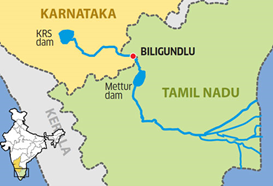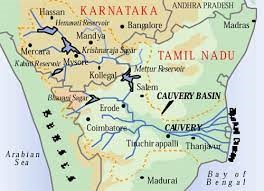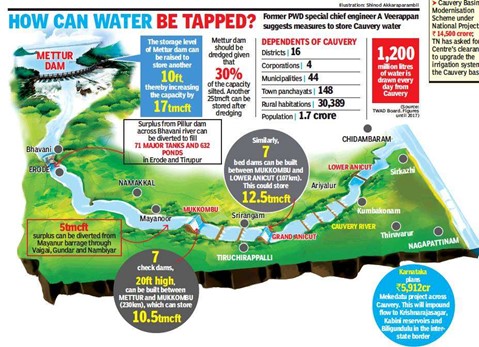PREVIOUS
Mettur Dam
July 6 , 2023
924 days
61107
0
(இதன் தமிழ் வடிவத்திற்கு இங்கே சொடுக்கவும்)

- The Mettur Dam is one of the largest dams in India and the largest in Tamil Nadu, located across the river Kaveri where it enters the plains.
- Maximum height and width of the dam are 214 and 171 feet, respectively.
- The dam receives inflows from its own catchment area, Kabini Dam and Krishna Raja Sagara Dams located in Karnataka.
- There is a park at the base of the dam called Ellis Park maintained by the Tamil Nadu Public Works Department.
- It provides irrigation and drinking water facilities for more than 12 districts of Tamil Nadu and hence is revered as the life and livelihood-giving asset of Tamil Nadu.

History
- It was constructed under the supervision of an Irish engineer, Vincent Hart, who was also the chief engineer of the project.
- It took nine years and the effort of 17,000 men to complete the dam project.
- After the construction was complete, Mettur Dam over Kaveri became the largest dam in the world.
- The funds were provided from the taxes collected in the Madras Presidency.
- The Board of Revenue was headed by Sir C.P. Ramaswamy Iyer who initiated the building of the dam.
- As a result, the dam authorities evacuated the people of Nayambadi and some other villages where the dam was sited.
- When the water level of the reservoir recedes, even now old Christian Church of Nayambadi and some Hindu temples from other villages emerge from it as proof.
- Those people who migrated from Nayambadi have settled down in Martalli, Cowdalli and other nearby villages in the Kollegal taluk of Chamarajanagar district of the state of Karnataka.
Capacity
- The total length of the dam is 1,700 metres (5,600 ft).
- The dam creates Stanley Reservoir.
- The Mettur Hydro Electrical power project is also quite large.
- The dam, the park, the major hydroelectric power stations, and hills on all sides make Mettur a tourist attraction.
- Upstream from the dam is Hogenakkal Falls.
- The maximum level of the dam is 120 ft (37 m) and the maximum capacity is 93.47 tmc ft.
- Area of reservoir 42.5 square kilometer.
- Its capacity of 93.4 billion cubic feet (2.64 km3) is nearly twice that of its Karnataka counterpart of KRS.
- It was built in-line with KRS Dam, which was designed by Sir M Vishveswariah in 1911 and completed in 1931 near Mysore.

Background of the Dispute
- The Mettur Dam is frequently in news during the recent past because of the Cauvery water dispute between the States of Tamil Nadu and Karnataka.
- Consequent to building dams, including the Kabini Dam, across the Kaveri River in Karnataka, the Mettur Dam does not receive adequate water during lean seasons.
- Thus, the Dam nearly goes dry during certain parts of the year, when water is most needed by the farmers and public of Karnataka and Tamil Nadu.
- This has created serious dispute and tension between the neighbouring States of Tamil Nadu and Karnataka.

- The Cauvery Basin is an Inter-State Basin covering areas in Kerala, Karnataka, Tamil Nadu, and Union Territory of Pondicherry.
- Use and development of Cauvery Waters were regulated by agreements of 1892 and 1924 between the erstwhile Princely State of Mysore and province of Madras.
- The State of Kerala was not a party to this agreement.
- The 1924 Agreement expired at the end of 50 years and Government of Tamil Nadu made a formal request in July 1986 under the provisions of Inter-State Water Disputes Act, 1956 for constitution of a Tribunal.
- The Central Government constituted the Cauvery Water Dispute Tribunal in 1990.
- Soon after the tribunal was set up, Tamil Nadu demanded a mandatory injunction on Karnataka for the immediate release of water and other reliefs.
- This was dismissed by the tribunal.
- Tamil Nadu then went back to the Supreme Court which directed the tribunal to reconsider Tamil Nadu’s plea.
- The tribunal reconsidered Tamil Nadu’s plea and gave an interim award in 1991.
- It calculated the average inflows into Tamil Nadu over a period of 10 with 205 billion ft³ for Karnataka had to release Tamil Nadu in a water year.
- The tribunal further directed Karnataka not to increase its irrigated land area.
- Karnataka deemed this extremely inimical to its interests and issued an ordinance seeking to annul the tribunal’s award.
- The Supreme Court struck down the Ordinance and Karnataka was thus forced to accept the interim award and widespread demonstrations and violence broke out in parts of Karnataka and Tamil Nadu following this.
- In 1997, the Government proposed the setting up of a Cauvery River Authority which would be vested with far reaching powers to ensure the implementation of the Interim Order.
- But Karnataka strongly protested the proposal and Central Government then made several modifications to the powers of the Authority and came up with a new proposal to set up two new bodies, viz., Cauvery River Authority (CRA) and Cauvery Monitoring Committee (CMC).
- In the summer of 2002, the monsoon failed in both Karnataka and Tamil Nadu.
- Reservoirs in both states fell to record low levels and inevitably tempers rose.
- Tamil Nadu demanded that Karnataka honour the interim award and release to Tamil Nadu its proportionate share.
- Karnataka on the other hand claimed that the water levels were hardly enough to meet its own demands and ruled out releasing any water in the circumstances that prevailed.
- The Cauvery Water Disputes Tribunal announced its final verdict in 2007 according to which, Tamil Nadu gets 419 billion ft³ while Karnataka got 270 billion ft³.

- But the government of Karnataka, unhappy with the decision, filed a revision petition before the tribunal seeking a review.
- A meeting of the CRA was called on 2012 but the Karnataka chief minister walked out of the meeting.
- The focus now shifted to the Supreme Court which ordered Karnataka to release 1.25 billion ft³ of water every day unless CRA revised it.
- Karnataka started the release of water but pressed for another meeting of the CRA.
- In the next meeting, Karnataka government refused to release any water succumbing to the large-scale protests that had mounted in the Kaveri districts of the state.
- Tamil Nadu aghast at the defiance went back to the Supreme Court.
- Karnataka now resumed the release of water for a few days but stopped it again as a protesting farmer committed suicide by jumping into the reservoir and the protests threatened to take a dangerous turn.
- The centre stepped in and asked Karnataka to release the water.
- The SC meanwhile, in response to Tamil Nadu’s petition asked the CRA for details of the water release and water levels in the reservoirs.
- The CRA in turn ordered for the inspections of the reservoirs.
- While the CRA inspected the reservoirs in Karnataka, Tamil Nadu refused to grant them permission to inspect its reservoirs.
- On 30 September the Supreme Court ordered Tamil Nadu to co-operate with the CRA and Tamil Nadu gave in.
- On Sep 24, 2012, Tamil Nadu Chief Minister directed the officials to immediately file a petition in the Supreme Court seeking a direction to Karnataka to release Tamil Nadu its due share of water.
- On Sep 28, 2012, the Supreme Court slammed the Karnataka government for failing to comply with the directive of the CRA.
- Left with no other option, Karnataka started releasing water.
- This led to wide protests and violence in Karnataka.
Mettur Surplus Water Scheme

- Mettur Surplus Water Scheme (Also called Sarabanga Lift irrigation project) was announced in the year 2019 by then Chief Minister Edappadi K. Palaniswami at the cost of Rs. 545 crores.
- The scheme aimed at diverting surplus flood waters released from Mettur dam into 100 dry lakes in the region.
- When Mettur dam gets filled, the water from the dam is taken to Thimmampatti pump house via canals.
- At Tippampatti 10 motors with a capacity of 940 horsepower will pump water through pipes to M. Kalipatti Lake 12 km away and 6 motors of 1080 horsepower will pump water through pipes to Nangavalli Lake.
- The water discharge from M.Kallipatti & Nangavalli lake is anticipated to fill multiple lakes & ponds.
- The scheme is expected to support agriculture in 4,238 acres of land in 40 villages & provide drinking water to 38 villages.
- The project got inaugurated in February 2021.
Leave a Reply
Your Comment is awaiting moderation.


